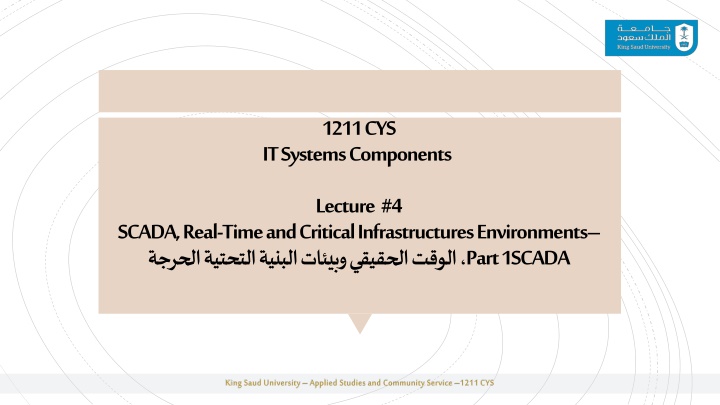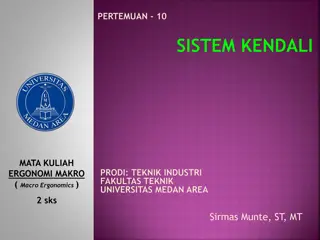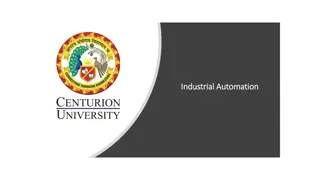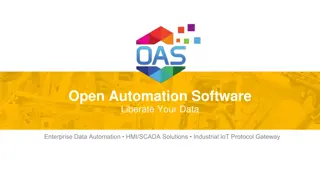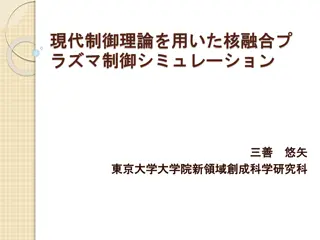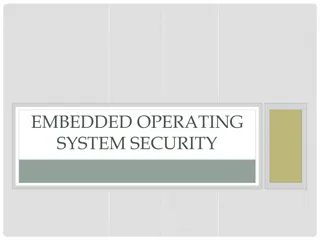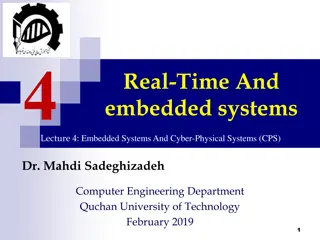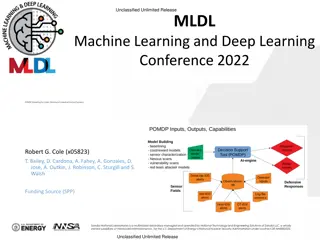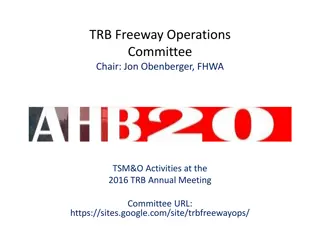Introduction to SCADA Systems in Control Operations
SCADA, or Supervisory Control and Data Acquisition, is a crucial component in industrial control systems, allowing for monitoring, controlling, and managing operations effectively. SCADA systems collect real-time data from sensors, enabling remote control and monitoring of equipment and conditions. Examples of SCADA use include industrial processes, infrastructure management, and agricultural applications.
Download Presentation

Please find below an Image/Link to download the presentation.
The content on the website is provided AS IS for your information and personal use only. It may not be sold, licensed, or shared on other websites without obtaining consent from the author.If you encounter any issues during the download, it is possible that the publisher has removed the file from their server.
You are allowed to download the files provided on this website for personal or commercial use, subject to the condition that they are used lawfully. All files are the property of their respective owners.
The content on the website is provided AS IS for your information and personal use only. It may not be sold, licensed, or shared on other websites without obtaining consent from the author.
E N D
Presentation Transcript
1211 CYS IT Systems Components Lecture 4 # SCADA, Real-Time and Critical Infrastructures Environments Part 1SCADA King Saud University Applied Studies and Community Service 1211 CYS
Topics SCADA (Supervisory Control and Data Acquisition) The concept of SCADA system in control operations SCADA Examples of use SCADA SCADA" " SCADA system components SCADA SCADA Data processing SCADA Scada system function SCADA Features of Scada systems SCADA SCADA Security Best Practices SCADA King Saud University Applied Studies and Community Service 1211 CYS
Describe SCADA system components. SCADA. Describe SCADA Data processing and system function. SCADA. Objectives Identify SCADA Security Best Practices. SCADA. King Saud University Applied Studies and Community Service 1211 CYS
SCADA Supervisory control and data acquisition (or SCADA for short) is a term that refers to industrial control systems, and it is a computer system for monitoring and controlling operations, and the nature of these operations changes according to the systems prepared for them. SCADA ( ) . King Saud University Applied Studies and Community Service 1211 CYS
The concept of SCADA system in control operations SCADA SCADA system is a system that collects data from the sensors located in the control system and sends it to the main computer for the purpose of management, control and monitoring. It is an application software used for control operations in which real- time data is collected from remote locations equipment and conditions and at the same time control them. to surrounding monitor King Saud University Applied Studies and Community Service 1211 CYS
SCADA . .
Examples of use SCADA " SCADA" The SCADA system is widely applied as it serves as a broad umbrella that contains solutions to a wide range of problems, for example, but not limited to: - Industrial processes with all their differences, from manufacturing, production, electricity generation, refining... - Infrastructure, such as water treatment and distribution, petroleum pipelines, electricity distribution lines, and large communications systems. - Agricultural applications and modern irrigation systems. King Saud University Applied Studies and Community Service 1211 CYS
SCADA : ... . .
SCADA system components SCADA The SCADA system includes two parts of the software equipment and the physical equipment. The physical equipment collects data from the different stations by linking it to the sensors on the equipment and sends it through the communication system to a control center that contains the computers that carry the software. The latter, in turn, processes the data, represents it and displays it in the form of graphics so that it can The user is able to monitor them, as well as take decisions to enter or remove units, as necessary. In general, the SCADA system consists of four stages in a sequential manner, from the different stations to the control center: 1. The data collection stage consists of units (RTU remote terminal unit & DAS Data Acquisition System ) and is directly connected to the devices through sensors. 2. The communication unit between the collection stations and control centers and the medium used to transfer information. 3. Control centers, which contain computers and control programs. 4. Information display units: to display the information after it has been processed and the data of the position of the equipment at work.. King Saud University Applied Studies and Community Service 1211 CYS
SCADA . SCADA : ( RTU " " . . . . . . )" DAS " :
SCADA Data processing SCADA What distinguishes the SCADA control and monitoring system is its unique structure through which we can carry out the data collection and processing process through a large number of input / output devices that can take different forms in the way they are connected to provide us with various servers specialized in various purposes, these All of them form a solid system that collects data and helps control procedures and decision-making. The function of the servers and computers in the control centers is summarized in the following tasks: 1- I/O It handles and configures all communications with input and output devices. 2- Alarm -It monitors all alarm conditions, whether analogue or digital. 3: Reports It is the control, scheduling and issuance of all reports about operations. 4: Trends Its mission is to compile, record and issue expressive curves. 5: Display - It represents the communication interface between the worker and the system, and it communicates with all the tasks before it all in order to show the latest new information and execute orders. King Saud University Applied Studies and Community Service 1211 CYS
SCADA : 1 - / ( I/O) - . 2 - - . 3 - - . 5 - . / . / - 4 - . -
Scada system function SCADA The basic functions of a SCADA system are: - Data collection: SCADA systems collect data from various sensors and equipment directly in real time. - Continuous monitoring of various variables such as voltage, current, and others. - Data analysis: The SCADA system analyzes data collected from sensors and equipment, and generates reports and alarms based on this data. - Direct remote control of the equipment - Data Storage: SCADA systems store historical data for future analysis and troubleshooting. - Automatically perform operations such as switching between transmission lines. King Saud University Applied Studies and Community Service 1211 CYS
SCADA : . . : SCADA . : SCADA . . : SCADA
Features of Scada systems SCADA Increase Efficiency: SCADA systems can automate many processes, such as monitoring and controlling industrial processes, reducing the need for manual intervention. This automation improves efficiency and productivity and can help organizations reduce costs. Real-time Monitoring: SCADA systems allow direct real-time monitoring of various parameters such as temperature, pressure, voltage, current, and others. This helps workers identify any problems early and take action before significant damage occurs. Remote access to SCADA systems: meaning operators can monitor and control operations remotely. This is especially useful for large or geographically dispersed systems, Data management: SCADA systems collect and store large amounts of data, which helps organizations make accurate decisions. Increased Safety: SCADA systems help increase safety by providing alerts at the onset of any problem, allowing operators to take action before any damage or accidents occur. King Saud University Applied Studies and Community Service 1211 CYS
SCADA Security Best Practices SCADA While organizational circumstances may be different, these best practices can guide any organization looking to step up their security. Each step builds on the ones before it, so consider implementing in sequential order. 1. Diagram all network traffic: Creating a diagram that shows all network traffic between Programmable Logic Controllers (PLCs control device, It is used to control mechanical actuators"), devices, external software systems.. 2. Encrypt any unencrypted connection : If any connections aren t encrypted, make sure access to that network is secured. Database connections may be easy to encrypt, while a PLC connection could be difficult. Examine the firewalls that are in place and decide which connections should be encrypted. 3. Invest in an Intrusion Detection System (IDS): Having an IDS for a controls network allows easy detection of unauthorized access into the network. 4. Consider a data diode: For extremely sensitive networks that don t need outside data, consider using a data diode, which only allows data to flow out of a network, but not flow into it, thus cutting off one major vector of attack. While this may not pertain to everyone, a data diode can guarantee there is no communication from the outside to a specific piece of equipment. King Saud University Applied Studies and Community Service 1211 CYS
. 1. ( " )" , .. 2. . PLC . 3. ( IDS): IDS . 4. . . : PLCs : . : .
SCADA Security Best Practices 5. Determine your risk profile: Organizations can spend overly large amounts of time and money implementing security procedures, layering security effort over security effort, and some of it may be unnecessary. To help decide what s secure enough for each organization. 6. Understand the options and the limits of software and hardware: While there are some exceptions, many modern PLCs do not have security tools built inside of them, McClusky says. If your hardware or software won t do encryption out-of-the-box, you ll need to retrofit them to put encryption in place. If you don t know the options when you purchase hardware, there s no way to do a good job with your security, . To prevent retrofitting software and hardware, look out for the growing number of devices, PLCs and products, such as Inductive Automation s Ignition, that are being designed with security directly built in 7. Employ two-factor or multi-factor authorization (MFA/2FA) and single sign-on (SSO): wider access can lead to greater security risk in the event someone s login credentials become compromised. wider access can lead to greater security risk in the event someone s login credentials become compromised. King Saud University Applied Studies and Community Service 1211 CYS
: 5. . " " . 6. : " . " Inductive Automation . 7. ( . . PLCs MFA/2FA) ( SSO):
Discuss the SCADA main component and security best practice? King Saud University Applied Studies and Community Service 1211 CYS
End of Lecture King Saud University Applied Studies and Community Service 1211 CYS
